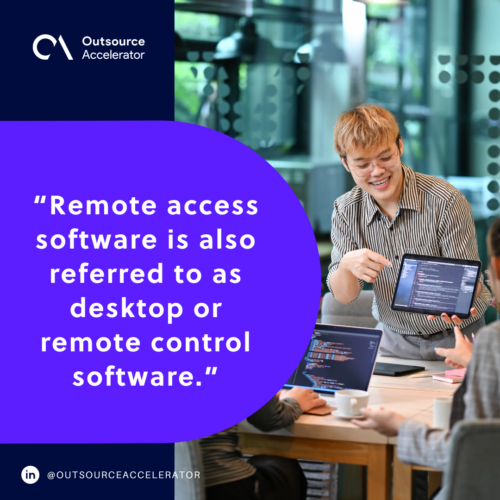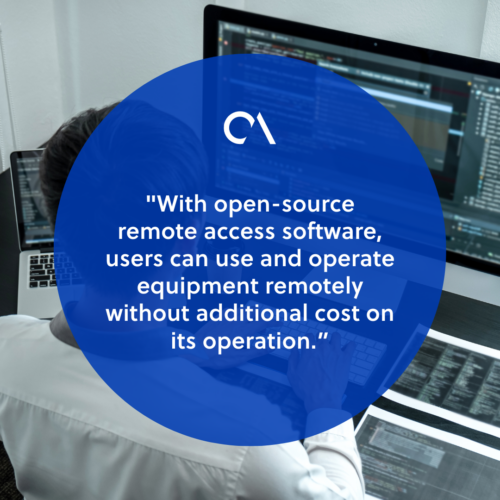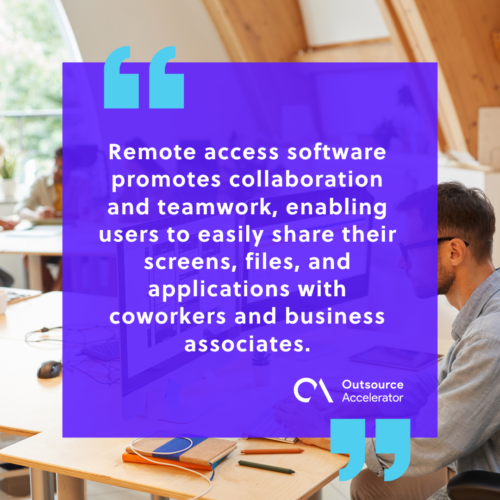Remote access software: A vital tool for a hybrid workplace

The benefits of having flexible work arrangements have significantly changed practices in providing service delivery.
More and more businesses are opting for a hybrid workplace. Hiring remote workers allows them to continue operations without geographical or time-zone restrictions.
This model became more crucial and is now translated into a long-term strategy for many due to its benefits, which comprise enhanced work-life balance and modernized service productivity.
Because employees deliver work outputs in remote locations, many technology-based strategies are introduced to help them perform tasks more easily.
However, the challenges related to sharing files, data, and other information stored on physical offices paved the way for highlighting the work of remote access software.
What is remote access software?
Remote access software is also referred to as desktop or remote control software. It enables users to navigate and access a computer or other devices from a remote or out-of-office location.
Using this technological solution, a remote worker can simply access files required to complete duties like reports, presentations, and data analysis.
For IT support staff, remote access software is very significant, especially when troubleshooting and running applications that are important to maintaining IT systems and equipment.
It facilitates the organization’s ability to operate consistently as if remote staff were physically working at the location of the computer or devices.

How remote access software works
A remote access software utilizes a local device as a platform to connect to a specific remote device in the company’s physical office.
The software is installed to both devices through proper configuration. Certain information like hostname, IP address, and a software’s unique code are needed before it starts working.
After authentication and security verification, the connection can be established through a local network or the Internet.
To guarantee that the software sustains its performance quality, software providers now offer remote access with quality assurance services.
The configuration settings will adjust to mirror the local device’s interface on the computer, granting the user access to operate the desktop.
The mouse and keyboard are the basic tools for managing remote devices. They help process data transfer, video tele-conferencing, and online communication between local and remote users.
The software activity typically concludes by ending the access session, with the option for the remote user to log off or put the device in sleep mode.
4 common types of remote access software
Remote access software comes in different types where businesses can choose from. It varies depending on the kind of devices and what is convenient for the IT equipment in the office.
Here are some of the common types of remote access software that your business may consider:
1. Virtual Private Network (VPN)
Virtual private network (VPN) software creates a channel connecting your local computer and the network available to the office where the remote device is located.
Setting up the VPN software requires configuration for the office network or the remote user network to enable and run the VPN properly.
This remote access setting shares real-time experience with the users, making them sense the mood of working physically in front of the remote device.
2. Software-as-a-Service (SaaS) remote tools
Software vendors provide pre-built SaaS solutions for remote access tools to perform various tasks and functions, including remote access services.
Adapting this to a remote access function also connects two devices in separate locations. Firms must download and set up the software to the devices using a corresponding authentication process.
SaaS solutions are one of the most in-demand remote access tools today because of their convenience and cheaper cost compared to other types.
3. Direct remote service ports
Working similarly to cloud computing and SaaS remote access software, remote service ports allow local users to access remote computers from a certain location.
Instead of availing services of a software service provider, commonly used protocols and services are installed in the operating system of the devices, including the following:
- Virtual network computing (VNC)
- Remote desktop protocol (RDP)
- Secure shell protocol (SSH)
4. Open-source remote access software
With open-source remote access software, users can use and operate equipment remotely without additional cost on its operation. It supports startups and small scale businesses with limited resources.
It is usually an easy-installed software with basic navigation features that allow users to monitor and share files using software source code.
This software is advantageous for companies and employees seeking adaptability, transparency, and collaborative growth.

Key benefits of remote access software
Remote access software offers various advantages for entrepreneurs, small-scale businesses, and organizations.
Here are some of the notable benefits provided by a remote access software:
Convenience and added flexibility
Remote access software enhances a business’s flexibility by allowing users to conveniently access computer applications and files from any location, thanks to its features.
Some companies are also outsourcing, mainly for back-office support tasks performed by virtual talents. Remote access makes it more convenient for them to go through necessary data from a remote device to accomplish their assigned task.
Improved service productivity
Continuity of task performance is a vital element in ensuring that targets and deadlines are met by the project plan or execution timelines.
Remote access software enables remote workers to seamlessly access office devices, ensuring productivity even when they cannot be physically present at the office.
It eliminates the risk of adjusting targets while providing additional benefits for employees. It does not require employees to commute and have non-traditional working hours, leading to a work-life balance.
Cost-effectiveness
Adapting a hybrid workplace helps the organization lessen operational costs, attributing to utility expenses, office space, equipment, and infrastructure.
Over time, remote work has helped many organizations boost profits by cutting operational costs related to travel, meetings, and conferences.
Effective IT support and troubleshooting
Software applications and IT-related tasks require in-depth monitoring and ensure systems are working. Unstable performance will significantly affect the operation of the business.
These factors can be prevented by using remote access software. It shares the capability for IT support personnel to continuously check the systems outside the premises where infrastructures are installed.
They can perform diagnostics and address issues in real-time, leading to a more effective IT support and troubleshooting mechanism.
Security and data protection
Remote access software comes with security features due to the nature of its function. It includes authentication, encryptions, and added security configurations to secure shared data between the devices.
The software is backed with trusted security licenses, eliminating the risk of data attacks and cybersecurity-related crimes. It has the ability to centralize access to the organization’s critical systems.
Disaster recovery and business continuity
One of the challenges in having a business that integrates technology is the continuity of operation and fast recovery after the disruptions brought by natural calamities and other emergencies.
Remote access plays a significant role enabling IT professionals and support personnel to continue their tasks while working remotely and avoiding accidents that may occur going to work.
Collaboration and teamwork
Remote access software promotes collaboration and teamwork, enabling users to easily share their screens, files, and applications with coworkers and business associates.
Having remote access allows for the establishment of teamwork and collaboration even if some of the organization’s members are working outside the physical office.
The software serves as a hub or platform for the distributed team to work in real-time while sharing knowledge, expertise, and innovative ideas, on top of sharing devices’ accessibility.

Creating an ideal hybrid workplace with remote access software
With all the benefits and features of a remote access software, it is treated as a game changer that is revolutionizing many businesses of various industry verticals.
It establishes a strong branding by offering channels for collaboration, flexibility, and productivity to organizations, allowing them to create a fair hybrid workplace for remote and on-site employees.
Though being physically present at work also has its advantages, it is undeniable that working remotely shares numerous positive advantages to many.
Today, hybrid workplaces continuously evolve because of remote access software. It makes remote work more credible and reliable, particularly in areas of monitoring and accessibility of data.
A remote access software is a significant innovation for hybrid workplaces and is now recognized as a global solution.
Working and performing remote tasks has progressed so far, and introducing new conveniences aided by technology will always translate into advancement and progress.







 Independent
Independent




